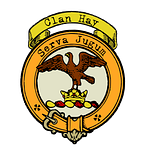Welcome to "A Clan A Day Podcast," brought to you by bagtownclans.com. I’m your host, Colin MacDonald. Today, we dive into the story of Clan Mackintosh, a family deeply rooted in Highland tradition, with origins stretching back to the 12th century. Known for their resilience, Clan Mackintosh played pivotal roles in Scotland's political, military, and clan conflicts, while also shaping the history of the confederation known as Clan Chattan.
The Mackintosh legacy begins with Shaw MacDuff, second son of Duncan, the 3rd Earl of Fife, a noble connected to Scotland’s ancient royal house. Shaw accompanied King Malcolm IV on a campaign in Moray around 1160, successfully quelling a rebellion. For his service, Shaw was made Constable of Inverness Castle and granted lands in Petty and Breachley, marking the beginning of the Mackintosh clan. The Gaelic term Mac-an-Toisich means “son of the chief” or “leader,” fitting for a family that would become principal figures in Scotland’s northern regions.
For the next century, Shaw’s descendants held Inverness Castle and defended their lands from frequent raids. The clan’s fortunes shifted in the late 13th century when Angus Mackintosh, the 6th chief, married Eva, heiress of Clan Chattan. This alliance brought lands in Glenloy and Loch Arkaig, as well as the leadership of Clan Chattan. This confederation of clans, including the Macphersons, Davidsons, and others, would soon face its own internal challenges, as the Macphersons contested Mackintosh’s leadership for centuries.
One of the most notable moments in the clan’s early history came during the Wars of Scottish Independence, when Angus supported Robert the Bruce, joining him at the Battle of Bannockburn in 1314. For this loyalty, the Mackintosh chief received lands in Badenoch, further strengthening their influence in the Highlands.
The Mackintoshes are perhaps best known for their intense feud with Clan Cameron, a conflict that spanned more than 350 years. The dispute began in the 14th century when Angus Mackintosh acquired lands in Lochaber, previously held by the Camerons. A series of battles ensued, including the Battle of Invernahavon in 1370, where a quarrel between the Macphersons and Davidsons nearly cost Clan Chattan the victory. This feud would also contribute to the famous Battle of the North Inch in 1396, where 30 champions from each side fought in front of King Robert III in Perth. The battle, immortalized by Sir Walter Scott, was part of the larger struggle between the Mackintoshes and Camerons.
The 15th and 16th centuries saw Clan Mackintosh involved in several significant events. Malcolm Beg Mackintosh, the 10th chief, expanded the clan’s territories and dealt a devastating blow to the Comyns, a once-powerful family who had seized Mackintosh lands. In retaliation for the Comyns’ betrayal, Malcolm led a massacre during a supposed reconciliation feast at Rait Castle, ensuring the downfall of his enemies.
In 1528, another turning point came when King James V issued a letter of fire and sword against Clan Mackintosh, leading to brutal conflicts that saw many clan members captured and executed. Yet, the clan survived, with Lachlan Mor Mackintosh emerging as a prominent figure. Lachlan supported Mary, Queen of Scots, and played a key role in her victory at the Battle of Corrichie in 1562. However, Lachlan’s later involvement in disputes with the powerful Earl of Huntly led to his betrayal and execution, a dark chapter in the clan’s history.
One of the most remarkable figures of the Mackintosh family was Anne, known as Colonel Anne of Moy. During the Jacobite Rising of 1745, while her husband, Angus Mackintosh, served with the British Black Watch regiment, Lady Mackintosh raised two battalions for Prince Charles Edward Stuart, the Young Pretender. Her cunning tactics were instrumental in the famous “Rout of Moy,” where a handful of her men deceived a large government force, causing them to retreat in panic. The Mackintoshes fought bravely at the Battle of Culloden, though the defeat of the Jacobites marked the end of their traditional way of life.
Following Culloden, the clan saw a gradual decline in its military and political power, though its legacy endured. In 1812, Aeneas Mackintosh was made a baronet, further cementing the family’s noble status. Today, the Mackintosh chief resides at Moy Hall, continuing the traditions of a clan that has left an indelible mark on Scotland’s history.
From their early role as defenders of Inverness to their leadership in Clan Chattan, the Mackintoshes have been at the heart of Scottish history for nearly 900 years. Their story is one of resilience, loyalty, and adaptability—qualities that define this great Highland clan.
Thank you for joining us on this journey through the history of Clan Mackintosh. Tune in tomorrow for another episode of "A Clan A Day Podcast." I’m Colin MacDonald, and as always, Go n-éirí an bóthar leat—may the road rise with you.













Share this post